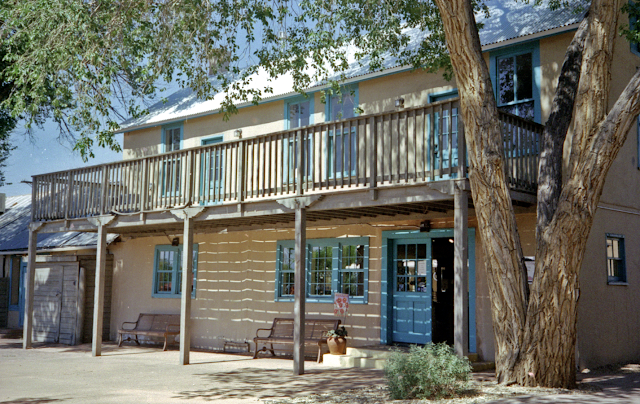Some media attention has been given lately to the discovery and dating of the preserved footprints of humans and extinct animals in the dry bed of an ancient lake in White Sands National Monument. The DNA of pollen associated with the prints suggests an age of twenty thousand years. That puts the arrival of humans in the New World much further back in time than previously thought. It also means that the humans were coexisting with some fearsome large predators including Saber-toothed Cats and Dire Wolves.
The Dire Wolf exhibit at the Natural History Museum is nicely lit by large nearby windows, making it an attractive subject for my cameras. On this occasion I was shooting my Olympus Pen-FT with the 1.8/38mm lens.Pages
Tuesday, July 30, 2024
Friday, July 26, 2024
One of My Hunters
Another image found in the recesses of my hard drive. I doubt I'll ever find the negative as it was made many years before I got my negative files in some kind of proper and retrievable order. There is likely a drugstore print in a box somewhere.
I took my first Red-tailed Hawk from California to Idaho and I had another there which I rehabed from a gunshot that blew off some wing feathers. Both birds were enthusiastic about bunnies and jackrabbits.
This shot was certainly from my Pentax Spotmatic as that was the only camera in the house for about twenty years.
Sunday, July 21, 2024
Lost and Found
I found these in a neglected corner of my hard-drive. They were made around twenty years ago at a field west of the Organ Mountains. No info attached to the photos -- they were likely made with the Spotmatic. I will try to track down the negatives to make some new scans.
UPDATE:
I was right about the timeframe; the pictures were made in February of 2004. However, the camera was not my Spotmatic, but rather the Kiev IIa loaded with Tri-X. Rescanning did not gain anything of interest beyond image size.
Still, I'm pleased I was able to find the negatives from twenty years ago.
Sunday, July 14, 2024
Inside and Out
I suspect a lot of people, when they first encounter a Minolta Hi-Matic 7s wonder if the fully automatic exposure system is really going to work. It just seems too easy to simply press the shutter release and get a perfectly exposed picture every time.
I experimented a bit with mine, checking the metered values when the camera was on full auto, and then with the shutter and aperture set manually. It did seem to be consistent in its performance, so it seemed the next step should be a real-world test. I started a roll of Kodak UltraMax 400 on Wednesday at the National Hispanic Cultural Center, and then took the camera on Friday for a walk around Old Town Albuquerque.
I could not find anything to complain about in how the HiMatic 7s handled the full range of lighting from dim interiors to full sun in the Plaza Vieja.
No camera, of course, is perfect. The display of EV values only in the meter leaves one wishing for aperture and shutter numbers. Size and weight are the other big issues. The camera, while of extraordinary build quality, is a heavy-weight among rangefinders. Here is a comparison picture showing the HiMatic 7s next to the little Olympus 35 RC, also having auto-exposure.
Seeing that Olympus was racing ahead in its light-weight design, Minolta did make the next model of the HiMatic much closer in size to the 35 RC. With use, though, one does get used to a bit of added bulk. And, the 1.8/45mm Rokkor lens on the Minolta has got to be one of the best lenses to emerge from the 1960s.Saturday, July 06, 2024
Small, But Mighty
I loaded a roll of Kodak UltraMax 400 and carried the 35RC around for a week, visiting my usual haunts around Albuquerque's Old Town. I've gotten in the habit of giving most of the films I use an extra stop of exposure beyond the box speed. However, the UltraMax 400 really seems to yield better results without that extra push.
I particularly like 400-speed film for sunny day hip shooting. With the focus set to ten feet, the shutter at 1/500 and a f16 aperture, about anything you point the camera at is going to be focused and sharp .
I finished off the roll on a Friday morning in the Plaza Vieja. The sleek Pontiac hardtop was one I hadn't seen there before. The little '32 Ford Victoria got to show off its engine.
Thursday, July 04, 2024
Close to Home
This wicker chair has been sitting for months beside the road a half block from my house; I pass by it daily when I'm walking the dog. I have made pictures of the chair with several cameras. This is the one I have liked most so far; it was shot on Kentmere 400 in my Yashica-Mat.
The summer monsoon weather pattern has been bringing some nice clouds overhead. I saw these above the alley a half block to the west of our place late in the afternoon.


























